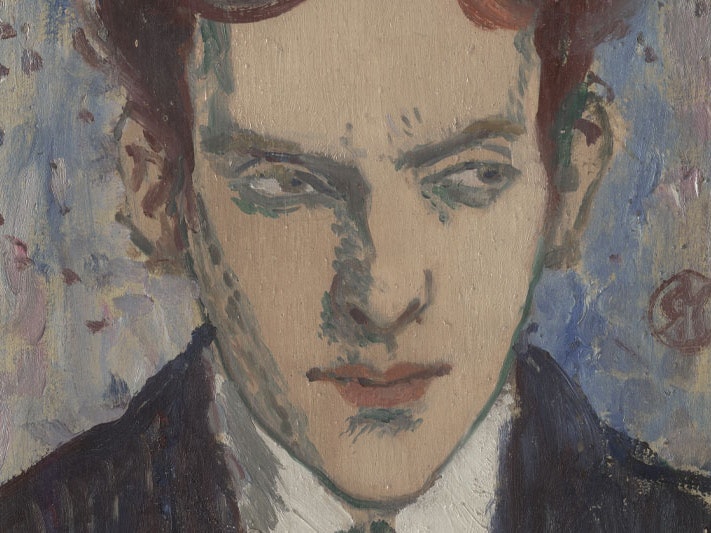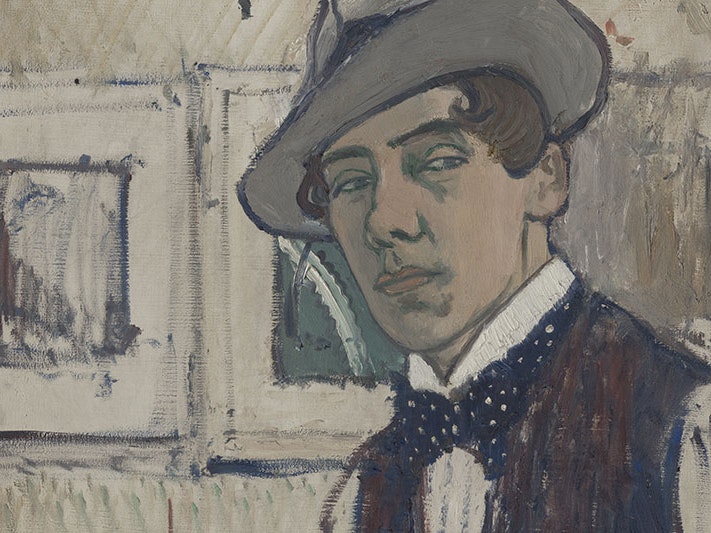
Edward McKnight Kauffer on Collections Online
More information about Edward McKnight Kauffer, including his portrait by Raymond McIntyre, on Collections Online.
Free museum entry for New Zealanders and people living in New Zealand
Open every day 10am-6pm
(except Christmas Day)
Free museum entry for New Zealanders and people living in New Zealand
Who is this man with this mysterious gaze? Curator Modern Art Lizzie Bisley unpacks Raymond McIntyre’s portrait of Edward McKnight Kauffer.
This is a painting by the Christchurch artist Raymond McIntyre.
It’s a portrait of his friend Edward McKnight Kauffer and it was painted in about 1915 when McIntyre was living in London.
The thing that I love about this portrait and always find so surprising about it is the expression on McKnight Kauffer’s face.
He has this kind of fabulously glowering look on his face and that’s not something that you see very often in a painted portrait.
The painting is also quite unusual within McIntyre’s practice.
He was born in Christchurch and initially did his training at the Canterbury School of Art and then moved to London in 1909 to continue his studies.
McIntyre, when he first arrived in London, painted a whole series of works which were very beautiful portraits of women’s heads and women’s faces.
And in those works you often had a feeling of kind of calmness and stillness and the women would be beautifully composed within these quite open canvases.
In this painting by contrast, McKnight Kauffer is very close up to us.
And he’s been cropped off at the top of the canvas, almost like a snapped photograph.
The painting is also much, much sketchier than McIntyre’s earlier work.
So if you look closely, you can see that there are places where the board, the primered board, is coming through between the brush strokes.
He hasn’t fully covered the board, he’s just done this beautiful pattern with these loose fluid brush strokes.
I also love the way that McIntyre’s used colour in this work.
So he’s got these very pronounced green and purple shadows around McKnight Kauffer’s face.
And this shows how aware he was of what was happening in contemporary art, particularly in France from the late 19th century, where you got a lot of artists like Vincent Van Gogh, Paul Gauguin, who were playing around with using non-naturalistic colours, colours that don’t appear in nature to create a kind of feeling of emotional energy in their subject.
The subject of the work is also very interesting.
Edward McKnight Kauffer was one of the most important graphic designers of the first half of the 20th century.
He was an American artist who trained initially in San Francisco, where he met a professor of art called Joseph McKnight, who was from Utah.
And McKnight believed very strongly in Edward Kauffer’s potential as an artist so he agreed to pay for Kauffer to go to Paris to continue his studies and as a mark of tribute to his patron Edward Kauffer took the name McKnight as his middle name.
He went to Paris and had to leave France with the outbreak of the First World War and moved across the channel to London, where he started to work as a commercial artist.
So he moved from being a painter into poster design.
And this is a time when a lot of artists were looking at posters as a kind of very immediate and democratic form of artistic communication.
So they were really interested in the potential of the poster as a way of accessing a huge number of people on the street and being part of the kind of day to day life of the city.
And McKnight Kauffer became one of the most adventurous and experimental poster designers of his generation, taking the most up to date ideas from contemporary art and using them in his poster designs.
And I think that relationship between this very radical experimental graphic designer and this young New Zealand painter who was playing with new ideas is so beautifully expressed in this portrait.

More information about Edward McKnight Kauffer, including his portrait by Raymond McIntyre, on Collections Online.

Explore more of Raymond McIntyre’s work on Collections Online.